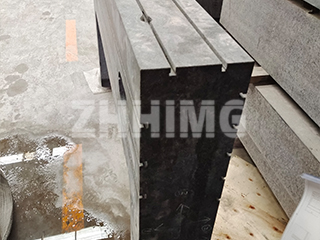Granite and marble mechanical components are widely used in precision machinery, especially for high-accuracy measurement applications. Both materials offer excellent stability, but they have distinct differences in terms of material properties, precision levels, and cost-effectiveness. Here’s a closer look at how granite and marble mechanical components differ:
1. Precision Grade Comparison
After selecting the stone type, the precision level becomes a critical factor. Marble surface plates, for example, are classified into different precision grades—such as Grade 0, 00, and 000. Among them, Grade 000 offers the highest level of accuracy, making it suitable for ultra-precision measuring applications. However, higher accuracy also means higher cost.
Granite components, especially those made from premium granite such as Jinan Black, are known for their excellent dimensional stability and minimal thermal expansion. This makes granite ideal for precision machine bases and coordinate measuring machine (CMM) structures.
2. Specification and Size Differences
The size and specifications of granite and marble components directly affect their weight, which in turn influences both material cost and shipping expenses. Large-size marble surface plates may become less economical due to their weight and fragility during transport, while granite components offer better structural performance and are less prone to deformation.
3. Material Selection
Stone quality plays a vital role in the performance of mechanical components. Marble materials commonly used include Tai’an White and Tai’an Black, each offering different color tones and structural densities. Granite materials—especially Jinan Black (also known as Jinan Qing)—are highly valued for their uniform texture, fine grain, and superior hardness.
While both granite and marble are natural stones and may have minor defects, granite tends to have fewer surface irregularities and better resistance to wear and environmental changes.
Visual and Structural Differences in Marble Plates
Marble, being a naturally formed material, often contains surface imperfections such as cracks, pores, color variations, and structural inconsistencies. Common defects include:
-
Warping or concavity (non-flat surfaces)
-
Surface cracks, pinholes, or stains
-
Irregular dimensions (missing corners or uneven edges)
These variations affect the overall quality and precision of the final product. According to national and industry standards, different grades of marble plates are allowed to have varying levels of imperfections—although top-grade products exhibit minimal flaws.
Conclusion
When choosing between granite and marble mechanical components, consider the following:
-
Precision requirements: Granite typically provides better long-term accuracy.
-
Cost and logistics: Marble may be lighter for small components but less stable for large-scale applications.
-
Material durability: Granite offers better wear resistance and structural strength.
For high-precision machinery, granite mechanical components—especially those made from Jinan Black—remain the preferred choice in many industrial applications.
Post time: Aug-05-2025

